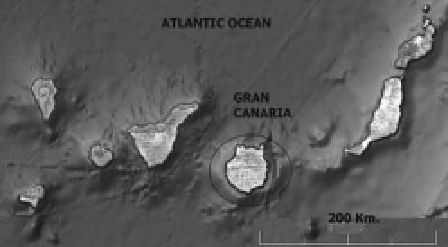Environmental Engineering Reference
In-Depth Information
Tunnel inventory of Grand canary island (spain), geology and
associated geotechnical problems
J.R. Jiménez & a. lomoschitz
Department of Civil Engineering, University of Las Palmas de Gran Canaria, Canary Islands, Spain
J. Molo
Área de Carreteras, Consejería de Obras Públicas y transportes, Gobierno de Canarias, Spain
aBsTRacT: in the last two decades more than 30 road tunnels has been built in Grand canary island,
using a variety of construction methods and reaching a total extension of 14.66 km. They are 156 to
1200 m long, with an average length of 458.20 m per tunnel. The inventory of tunnels includes basic
design data (i.e., geometry, widths and number of lanes, velocity), geological formations and materials
and the most relevant geotechnical problems. The article shows three tunnel examples which were exca-
vated in different volcanic rocks: (1) Basanite pyroclast and lava flows in the Tafira ring road (Gc-4);
(2) Phonolite lava flow and agglomerates at la laja (Gc-1); and (3) Phonolitic, trachytic and rhyolitic
ignimbrites and lava flows at arguineguín-Puerto Rico stretch (Gc-1). it is intended that this tunnel
inventory could be useful for future projects and works in the canary islands.
1
inTRoDUcTion
1.1
Situation and interest of the topic
The island of Gran canary is placed in the center
spreads over 243 km of coast, with long beaches
of sand, placed predominantly in the south, and
with areas of dunes and sandbanks now in the
south of the island, and until a few years ago in
the north of the island between la isleta and
Grand canary.
coves and beaches, big cliffs, extensive moun-
tains, well-preserved craters and impressive ravines
with subtropical vegetation and nature reserves are
some of his many characteristics, which mark the
big present changeability in Gran canary.
Figure 1. canary islands. localization of Grand
canary island.
three-lane tunnel. Thus began the era of artificial
tunnels to solve slope stability in big works.
But it was in 1990 when start in Gran canary
the tunnels Julio luengo at the northern entrance
to las Palmas de G.c., and the two pairs of tun-
nels on the motorway Gc-1 in Pasito Blanco and
arguineguín.
in 1994 the tunnel of the water maker was
built, to three lanes of the roadway south of the
Gc-1 solution to support the future connection of
the bypass to las Palmas.
it is from 1998 when building the new tunnel
adolfo cañas, for three lanes of the roadway itself
cited above, a length of 1250 meters, including
artificial tunnels in both access, thus saving the la
laja beach and rearrange the access to the south
of the capital of the island. linares, h. (1989).
1.2
Situation and interest of the topic
Until 1970 only existed in Grand canary two tun-
nels, Tenoya's tunnel, 200 meters long, a section
that shares a pedestrian sidewalk and has only one
lane of traffic of alternative sense, and the tun-
nel of la Punta de la laja, less than 100 meters
length and two-way traffic, demolished in 1972
when he switched to four-lane highway Gc-1.
in the early seventies the three tunnels were
built from the c-821 between arguineguín and
Puerto Rico.
in 1981, entered service a tunnel 80 meters long,
two lanes, and over 400 linear meters of artificial
















